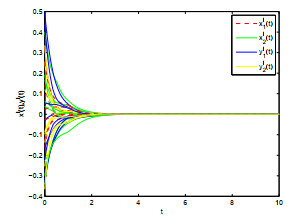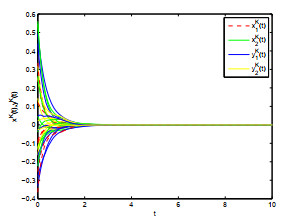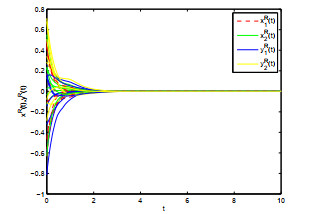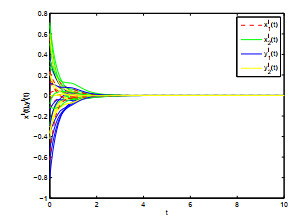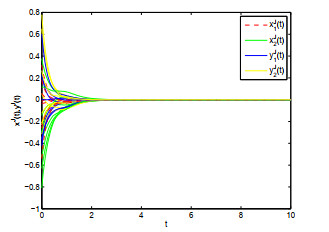Receptive fields of retinal and other sensory neurons show a large variety of spatiotemporal linear and non linear types of responses to local stimuli.In visual neurons, these responses present either asymmetric sensitive zones or center-surround organization. In most cases, the nature of the responsessuggests the existence of a kind of distributed computation prior to the integration by the final cell which is evidently supported by the anatomy.We describe a new kind of discrete and continuous filters to model the kind of computations taking place in the receptive fields of retinal cells. To show their performancein the analysis of different non-trivial neuron-like structures, we use a computer tool specifically programmed by the authors to that effect. This tool is also extended to studythe effect of lesions on the whole performance of our model nets.
1.
Introduction
Quaternion is a hypercomplex extended from real and complex numbers, which was first introduced by W. R. Hamilton in 1843 [1]. A famous characteristic of quaternion numbers is that the commutativity law no longer holds for its multiplication. In the past decades, quaternion-valued neural networks (QVNNs) have become a hot topic in research due to its strong ability to cope with high-dimensional data [2]. QVNNs are extended from real-valued NNs (RVNNs) and complex-valued NNs (CVNNs). The state value, connection weights, and activations of QVNNs are all taken values in the quaternion area. Compared with CVNNs and RVNNs, QVNNs improve the computation speed substantially and have great potential in high-dimensional data processing, attitude control [3], computer graphics [4,5], image compression [6], and optimization [7]. Recently, some results on the dynamical property of QVNNs have been reported [8,9,10,11,12,13,14,15]. Q. Song and X. Chen [11] investigate the multi-stability of delayed QVNNs with a decomposition of the state space. In [14], sufficient conditions for the global $ \mu $-stability were derived by using the decomposition technique and quaternion linear matrix inequality (LMI). The state estimation issue of QVNNs was considered in [13], in which some criteria are achieved via quaternion LMI. Till now, the investigation on stabilization of QVNNs are still very few.
The BAMNNs is a famous network model, which was first introduced by Kosko in 1987 [16,17]. By iterations of backward and forward information flows between two layers, this network owns the ability of information association and information memory. BAMNNs have broad applications in various areas including associative memory, pattern recognition and automatic control. Moreover, the research of BAMNNs has received broad interests, in particular, various kinds of dynamical behaviors of this type of network have been investigated extensively, such as exponential stability, synchronization, Lagrange stability, dissipativity, and etc. [18,19,20,21,22]. However, to our best knowledge, the study on the dynamics of BAMNNs has been mainly concentrated on the real and complex field, corresponding results on the quaternion field has not appeared yet. Due to the abundant dynamical behavior of QVNNs and BAMNNs, our research is novel and has a promising application prospect. On the other hand, most of the previous literatures on BAMNNs and QVNNs only consider constant connection weights. In fact, due to the existence of external disturbances and uncertainty, the time-varying parameters are more reasonable than constant coefficients and can better adapt to the real-world systems.
Stability and stabilization are important topics in the study of network systems, which have been widely applied to various fields, such as associative memory, optimization, and pattern recognition [23,24,25,26,27,28,29,30,31]. So far, the traditional stabilization control has been focused on the case that the convergence time tends to infinity. However, in many practical applications, the state trajectories are required to converge to zero in finite time. To meet with this need, the concept of finite-time stability (FTS) was proposed. The finite-time control does not only reduce the convergence time effectively but also improve the robustness of the system [25,26,27]. Unfortunately, the settling time of finite-time control relies on the initial state of a system, which may be unavailable in many engineering processes. To overcome this limitation, the fixed-time control was introduced. As a special case of FTS, the settling time of fixed-time stability can be estimated even without the initial information. This is a quite meaningful advantage and due to this reason, the fixed-time control has become a hot topic [28,29,30,31]. Furthermore, to reduce the high control strength and save energy, the adaptive control strategy is proposed in this paper. By designing proper adaptive laws, the control gains are increasing according to the adaptive laws [32,33,34,35,36]. Therefore, adaptive control can be applied even when the accurate information of the system parameters is unavailable. To our best knowledge, the adaptive fixed-time control method has not been applied to quaternion systems yet.
The purpose of this paper is to explore the fixed-time stabilization of quaternion-valued BAMNNs with time-varying coefficients. The main novelty of this paper is as follows.
1) It is the first time that the quaternion and time-varying coefficients are introduced into BAMNNs. The new network model is more general than previous suggested ones and can arouse a more complex dynamical behavior.
2) A novel fixed-time convergence method is adopted to deal with the stabilization problem, the traditional fixed-time technique is a particular case of our method.
3) To overcome the noncommutativity of quaternion, two different methods are proposed, i.e., a decomposition and a non-decomposition method.
4) For the first time, the adaptive control strategy is applied to the fixed-time stabilization of QVNNs, which can reduce the control strength effectively and avoid the computation of control gains.
The contents of our paper is as follows. In chapter 2, the BAM OVNNs model is introduced. The main theorem are given in chapter 3. In chapter 4, simulations are given to demonstrate the correctness of our results. Lastly, conclusion is derived in chapter 5.
Notations. In this work, $ R, C $ and $ Q $ denote the real field, complex field, and quaternion field, respectively. For any vector $ \chi = (\chi_{1}, \cdots, \chi_{n})^{T}\in R^{n} $, it is noted that $ |\chi| = (|\chi_{1}|, \cdots, |\chi_{n}|)^{T} $. The 1-vector norm of $ \chi $ is defined as $ \|\chi\|_{1} = \sum\limits_{q = 1}^{n}|\chi_{q}| $. For any vector $ x, y\in R^{n} $, $ x\leq y $ means that $ x_{i}\leq y_{i} $ for $ i = 1, \cdots, n $. For any vector $ x\in Q $, $ |x| $ denote the modulus of $ x $. $ \forall a, b\in R $, $ a\bigwedge b $ denotes the minimum of $ a $ and $ b $, $ a\bigvee b $ represents the maximum of $ a $ and $ b $.
2.
Preliminaries and model formulation
Quaternions are a kind of hypercomplex, which are an extension of complex numbers. A quaternion $ y\in \mathbb{Q} $ can be described as
where $ y^{R}, y^{I}, y^{J}, y^{K}\in R $, the imaginary parts $ i, j, k $ obey the Hamilton rule:
For any quaternion $ q = q^{R}+q^{I}i+q^{J}j+q^{K}k $, the conjugate of $ q $ is denoted by $ q^{*} = q^{R}-q^{I}i-q^{J}j-q^{K}k $. The modulus of $ q $ is defined as
For any two quaternions $ y = y^{R}+y^{I}i+y^{J}j+y^{K}k $ and $ z = z^{R}+z^{I}i+z^{J}j+z^{K}k $, addition is defined as
Based on the Hamilton rule, the product of any two quaternion numbers is defined as
With the introduction of time-varying coefficients and quaternion into traditional BAMNNs, the model of time-varying quaternion-valued BAMNNs is introduced as follows:
where $ p = 1, 2, \cdots, n, q = 1, 2, \cdots, m $; $ x_{p}(t), y_{q}(t)\in Q $ represent the state value of the $ p $th neuron in the $ F_{X} $-field and the $ q $th neuron in the $ F_{Y} $-field, respectively. $ c_{p}(t), d_{p}(t)\in R $ are the time-varying self-feedback coefficients; $ f_{q}(y_{q}(\cdot)), g_{p}(x_{p}(\cdot)):Q\rightarrow Q $ denote the activation functions of the $ q $th neuron from the $ F_{Y} $-field and the $ p $th neuron from the $ F_{X} $-field, respectively. $ a_{pq}(t) $, $ b_{pq}(t), \tilde{a}_{qp}(t), \tilde{b}_{qp}(t)\in Q $ represent the time-varying connection weights. $ \tau_{1}(t), \tau_{2}(t) $ are time-varying delays. $ \omega_{p}(t), \xi_{q}(t)\in Q $ are bounded external disturbances satisfying that $ |\omega_{p}(t)|\leq\hat{\omega}_{p}, |\xi_{q}(t)|\leq\hat{\xi}_{q} $. $ u_{p}(t), v_{q}(t) $ are the control input vectors.
where $ A(t) = (a_{pq}(t))_{n\times m}, B(t) = (b_{pq}(t))_{n\times m}, \tilde{A}(t) = (\tilde{a}_{qp}(t))_{m\times n}, \tilde{B}(t) = (\tilde{b}_{qp}(t))_{m\times n} $.
Assumption 1. Suppose that the quaternion-valued activation function $ f(x(t))\in Q^{m}, g(x(t))\in Q^{n} $ can be expressed as
where $ f^{\pi}(x^{\pi}(t))\in R^{m}, g^{\pi}(x^{\pi}(t))\in R^{n}, \pi = R, I, J, K $.
Remark 1. In fact, Assumption 1 is quite restrictive because not every quaternion activation function can be explicitly expressed as real and imaginary parts. There are still a large number of quaternion functions that do not satisfy this condition. Moreover, there is a more general assumption as follows:
However, this assumption may cause complex computation in our analysis process. Furthermore, it can be extended by Assumption 1 without difficulty. Thus, we take Assumption 1 in our later discussion.
Based on the above assumptions, now we separate the QVNNs (2.2) into RVNNs. Let
According to the quaternion multiplication rule, the quaternion system (2.2) can be decomposed into four real-valued NNs
Let
then the compact form of system (2.3) is derived
where $ X(t) = (x^{R}(t)^{T}, x^{I}(t)^{T}, x^{J}(t)^{T}, x^{K}(t)^{T})^{T}\in R^{4n} $, $ Y(t) = (y^{R}(t)^{T}, y^{I}(t)^{T}, y^{J}(t)^{T}, y^{K}(t)^{T})^{T}\in R^{4m} $, $ C^{*}(t) = diag(C^{R}(t), C^{I}(t), C^{J}(t), C^{K}(t))\in R^{4n\times4n} $, $ D^{*}(t) = diag(D^{R}(t), D^{I}(t), D^{J}(t), D^{K}(t))\in R^{4m\times4m} $, $ F(X(t)) = (f^{R}(x^{R}(t))^{T}, f^{I}(x^{I}(t))^{T}, f^{J}(x^{J}(t))^{T}, f^{K}(x^{K}(t))^{T})^{T}\in R^{4m} $, $ G(X(t-\tau(t))) = (g^{R}(x^{R}(t-\tau(t)))^{T}, g^{I}(x^{I}(t-\tau(t)))^{T}, g^{J}(x^{J}(t-\tau(t)))^{T}, g^{K}(x^{K}(t-\tau(t)))^{T})^{T}\in R^{4n} $, $ U(t) = diag\{u^{R}(t), u^{I}(t), u^{J}(t), u^{K}(t)\}\in R^{4n} $, $ V(t) = diag\{v^{R}(t), v^{I}(t), v^{J}(t), v^{K}(t)\}\in R^{4m} $, $ \omega^{*}(t) = (\omega^{R}(t), \omega^{I}(t), \omega^{J}(t), \omega^{K}(t))^{T}\in R^{4n} $, $ \xi^{*}(t) = (\xi^{R}(t), \xi^{I}(t), \xi^{J}(t), \xi^{K}(t))^{T}\in R^{4m} $.
Assumption 2. Suppose that there exist positive diagonal matrices $ L_{1}\in R^{4m\times4m}, L_{2}\in R^{4n\times4n} $ such that the real-valued functions $ F(\cdot), G(\cdot) $ satisfy the following conditions
where $ X, X^{'}\in R^{4n}, Y, Y^{'}\in R^{4m} $ and
Moreover, $ F(0) = G(0) = 0 $.
Remark 2. For later discussion, we make the following notations: $ L_{1} = diag(L_{11}, L_{12}, \cdots, L_{1, 4m}) $, $ L_{2} = diag(L_{21}, L_{22}, \cdots, L_{2, 4n}) $. Note that, according to the boundedness of disturbances $ \omega_{p}(t), \xi_{q}(t)\in Q $, $ \omega_{p}^{*}(t), \xi^{*}_{q}(t)\in R $ are also bounded.
Definition 1. For the initial value $ x(t_{0}), y(t_{0}) $ of system (2.2), if there exists a constant $ T(x(t_{0}), y(t_{0})) > 0 $ such that
Then, the system (2.2) is said to be finite-time stabilized to the origin, $ T(x(t_{0}), y(t_{0})) $ is called the settling time.
Definition 2. System (2.2) can reach fixed-time stabilization if the conditions in Definition 1 hold and the settling time $ T(x(t_{0}), y(t_{0})) $ has an upper-bound $ T_{\max} $. The number $ T_{\max} $ is not dependent on initial condition of the system. That is, $ T(x(t_{0}), y(t_{0}))\leq T_{\max}, \forall x(t_{0}), y(t_{0})\in Q^{n} $.
Lemma 1. [30] Assume that the function $ V(\cdot): R^{n}\rightarrow R_{+}\bigcup\{0\} $ is continuous radically bounded and if there exists an indefinite function $ q_{1}(t) $ and a nonpositive function $ q_{2}(t) $ such that
for some $ 0 < \alpha < 1, \beta > 1 $ and $ q_{1}(t), q_{2}(t) $ satisfy that
and
for all $ t > t_{0} $, where $ q^{+}_{1}(s) = q_{1}(s)\bigvee0 $, $ q^{-}_{1}(s) = q_{1}(s)\bigwedge0 $ and $ N, M_{i}, \gamma_{i} (i = 1, 2) $ are positive constants. Then, $ V(t) = 0 $ for all $ t\geq T_{\max} $, and the settling time is
Proof. The proof can be referred to [30].
Lemma 2. For constants $ x_{1}, \cdots, x_{n}\geq0, 0 < p < 1, q > 1 $, the following condition holds.
Lemma 3. For any $ a, b\in Q $, the following inequalities hold.
3.
Main results
In this section, we aim to derive the criteria for fixed-time stabilization of quaternion-valued BAMNNs (2.1). Due to the equivalence between QVNNs (2.1) and RVNNs (2.4), we now focus on the fixed-time stabilization of RVNNs (2.4) instead of QVNNs (2.1). The state-feedback controller for RVNNs (2.4) is chosen as follows
where $ 0 < \alpha < 1, \beta > 1 $, $ sgn(X(t)) = (sgn(X_{1}(t)), \cdots, sgn(X_{4n}(t)))^{T}\in R^{4n} $, $ sgn(Y(t)) = (sgn(Y_{1}(t)), \cdots, sgn(Y_{4m}(t)))^{T}\in R^{4m} $, $ SGN(X(t)) = diag(sgn(X_{1}(t)), sgn(X_{2}(t)), \cdots, sgn(X_{4n}(t)))\in R^{4n\times4n} $, $ SGN(Y(t)) = diag(sgn(Y_{1}(t)), \cdots, sgn(Y_{4m}(t)))\in R^{4m\times4m} $. $ |Y(t)|^{\alpha} = (|Y_{1}(t)|^{\alpha}, \cdots, |Y_{4m}(t)|^{\alpha})^{T}\in R^{4m} $, $ |X(t)|^{\beta} = (|X_{1}(t)|^{\beta}, |X_{2}(t)|^{\beta}, \cdots, |X_{4n}(t)|^{\beta})^{T}\in R^{4n} $.
The matrices $ K(t) = diag(K_{1}(t), K_{2}(t), \cdots, K_{4n}(t))\in R^{4n\times4n} $, $ \Gamma(t) = diag(\Gamma_{1}(t), \Gamma_{2}(t), \cdots, \Gamma_{4n}(t))\in R^{4n\times4n} $, $ \Lambda(t) = diag(\Lambda_{1}(t), \Lambda_{2}(t), \cdots, \Lambda_{4n}(t))\in R^{4n\times4n} $, $ \Theta(t) = diag(\Theta_{1}(t), \Theta_{2}(t), \cdots, \Theta_{4m}(t))\in R^{4m\times4m} $, $ \Upsilon(t) = diag(\Upsilon_{1}(t), \cdots, \Upsilon_{4m}(t))\in R^{4m\times4m} $, $ \Xi(t) = diag(\Xi_{1}(t), \cdots, \Xi_{4m}(t))\in R^{4m\times4m} $ are control gain matrices to be determined. $ \rho(t), \varrho(t)\in R $ are control gains to be decided.
Theorem 1. Under the Assumption 1 and 2, if the control gains $ K_{p}(t), \Gamma_{p}(t), \Lambda_{p}(t), \Theta_{q}(t), \Xi_{q}(t), \Upsilon_{q}(t) $ satisfy the following conditions
where $ p = 1, \cdots, 4n, q = 1, \cdots, 4m $, and there exist positive constants $ N, M_{1}, M_{2}, \gamma_{1}, \gamma_{2} $ such that
Then, system (2.4) can be stabilized in fixed-time under controller (3.1). Equivalently, the quaternion-valued BAMNNs (2.1) can be stabilized in fixed-time.
Proof. Choosing the Lyapunov functional as below
Computing its derivative along trajectories (2.4), we have
Thus, we get
According to Lemma 2 and condition (3.2), we have
According to Lemma 1, the fixed-time stabilization of system (2.4) can be reached via controller (3.1). Furthermore, the settling time is estimated as
The proof is completed.
Remark 3. Recently, most of the existing studies on QVNNs [21,22,23,24,25,26] are mainly focused on a model with constant parameters. However, since the external disturbances widely exist, the time-varying coefficients considered in this paper are more reasonable, which makes the QVNNs model more general and it can be better applied to real world. Furthermore, the traditional fixed-time convergence approach requires the derivative of the Lyapunov functional to be indefinite, which is a significant limitation. Thus, the novel fixed-time convergence method is required to deal with this issue.
Remark 4. Note that Theorem 1 only focuses on the situation that the activation functions and connection weights can be decomposed into real numbers. In this way, the difficulty caused by noncommutativity of quaternion numbers are overcome. Unfortunately, in practical engineering systems, there are large number of quaternion-valued activations that can not be expressed explicitly by real and imaginary parts, which can cause the invalidity of Theorem 1. Thus, it gives us the motivation to develop a non-decomposition method for quaternion-valued BAMNNs.
Next, we will derive non-decomposition fixed-time stabilization criteria for system (2.1).
Assumption 3. Suppose that there exist positive constants $ l_{1q}, l_{2p} $ such that the activation functions $ f_{q}(\cdot), g_{p}(\cdot)\in Q $ satisfy the following conditions
Furthermore, $ f_{q}(0) = g_{p}(0) = 0 $, where $ x, y\in Q $.
The state-feedback controller for system (2.1) is designed as follows
where $ 0 < \alpha < 1, \beta > 1 $, and $ k_{p}(t) $, $ \theta_{p}(t) $, $ \lambda_{p}(t) $, $ \gamma_{q}(t) $, $ \delta_{q}(t) $, $ \mu_{q}(t)\in R $ are control gains to be determined.
Theorem 2. Under Assumption 3, if the control gains $ k_{p}(t) $, $ \theta_{p}(t) $, $ \lambda_{p}(t) $, $ \gamma_{q}(t) $, $ \delta_{q}(t) $, $ \mu_{q}(t) $ satisfy the following conditions
and there exist positive constants $ N, M_{1}, M_{2}, \gamma_{1}, \gamma_{2} $ such that
Then, the fixed-time stabilization of system (2.1) can be achieved under controller (3.6).
Proof. Choosing the Lyapunov functional as below
Computing the derivative along trajectories (2.1), we have
From the feedback controller (3.6), we yield
According to Lemma 3, we get
Combining the above inequalities, we have
According to Lemma 2 and the condition in (3.7), we get
Thus, the fixed-time stabilization of system (2.1) can be achieved under feedback controller (3.6). Furthermore, the settling time is estimated as
The proof is completed.
Remark 5. In most of the existing literature on the stability of NNs [22,23,24,25], the derivative of the Lyapunov functions are required to be negative definite, which is a strong limitation in practical use. Compared with that, since $ \rho(t) $ can be chosen as positive value, the derivative of the Lyapunov function in this work may not be negative definite. Thus, our result can be applied to a broader engineering area since the limitation of traditional Lyapunov functions are relaxed here.
Remark 6. The model proposed in this work combines both the characteristics of QVNNs and BAMNNs. As we know, the BAMNNs have a great information association and information memory ability. On the other hand, the imaginary parts of the quaternion neuron can better describe the human visual neuron cells and deal with multidimensional data more efficiently. Based on these strong engineering background, the BAM QVNNs model has a good application prospect and deserves further investigation.
It is well known that an adaptive control strategy can greatly reduce the control strength. In the following, we further investigate the fixed-time stabilization via an adaptive method. The update law for the adaptive parameters in controller (3.6) is
where $ p = 1, \cdots, n, q = 1, \cdots, m $, $ 0 < \alpha < 1, \beta > 1 $. $ k_{p}, \theta_{p}, \lambda_{p}, \gamma_{q}, \delta_{q}, \mu_{q} $ are positive constants to be determined.
Assumption 4. Suppose that the time-varying coefficients $ a_{pq}(t), b_{pq}(t), \tilde{a}_{pq}(t), \tilde{b}_{pq}(t) $ are bounded, $ c_{p}(t), d_{q}(t) $ are lower bounded. i.e., there exist positive constants $ a^{M}_{pq} $, $ b^{M}_{pq} $, $ \tilde{a}^{M}_{pq}, \tilde{b}^{M}_{pq} $, $ c^{m}_{p}, d^{m}_{q} $ such that $ |a_{pq}(t)|\leq a^{M}_{pq} $, $ |b_{pq}(t)|\leq b^{M}_{pq} $, $ |\tilde{a}_{pq}(t)|\leq \tilde{a}^{M}_{pq} $, $ |\tilde{b}^{M}_{pq}(t)|\leq\tilde{b}^{M}_{pq} $, $ c_{p}(t)\geq c^{m}_{p} $, and $ d_{q}(t)\geq d^{m}_{q} $.
Theorem 3. Under Assumption 3 and 4, if the condition (3.8) in Theorem 2 holds. Then, the fixed-time stabilization of system (2.1) can be achieved under controller (3.6) and adaptive law (3.21).
Proof. Considering the Lyapunov functional as below
and
where the parameters are
Calculating the derivative of $ V_{2}(t) $, we get
Combining (3.24) with (3.19) in Theorem 2, and applying Assumption 3, we have
According to Lemma 2, we yield
Based on above discussion, system (2.1) can be stabilized with the fixed-time controller (3.6) and the adaptive law (3.21). According to Lemma 1, the settling time can be estimated as
Remark 7. In many previous studies on NNs [21,22,23,24,25], the time-varying delays are assumed to be bounded or derivative bounded. Compared with that, the time-varying delays $ \tau_{1}(t), \tau_{2}(t) $ considered in our paper do not have such restrictions. The basic assumption $ \tau(t)\leq\tau, \dot{\tau}(t)\leq1 $ is removed. Thus, the network model proposed in this work is more general and our research is very meaningful.
Remark 8. In Theorem 2 and 3, the QVNNs is coped with its quaternion form without a decomposition. Therefore, it can be used to deal with the activations or connection weights that cannot be explicitly expressed as real and imaginary parts, which make our results more general and promising for real applications. However, a disadvantage of this approach is that the Hamilton rule has not been fully taken into consideration, thus the effect of the sign of each real and imaginary parts are neglected. Hence, both decomposition and non-decomposition method are proposed in our work.
Remark 9. In [11,12,13,14,15], the dynamical behaviors of NNs are investigated by linear feedback control. The drawback of traditional feedback control is that the control gains must be maximal. Compared with that, by applying the adaptive method in this work, the control strength can be effectively decreased. Another advantage is that we even do not need to calculate the exact value of control gains, which is quite meaningful in real applications.
4.
Numerical examples
To verify the effectiveness of our theoretical results, some simulation examples are presented. Firstly, we consider the simulation of Theorem 1.
Example 1. Consider the following time-varying BAM QVNNs
where $ d_{1}(t) = d_{2}(t) = 2+|\cos t|, c_{1}(t) = c_{2}(t) = 1+|\sin t| $, $ \omega_{p}(t) = \sin(t), \xi_{q}(t) = -\cos(t) $. The transmission delay is $ \tau_{1}(t) = 0.5\sin(t)+0.5, \tau_{2}(t) = 0.5\cos(t)+0.5 $. The time-varying connection weights are given as below.
The activation functions are chosen as
Based on the above conditions, it is not difficult to check that $ L_{1} = diag(0.8, 0.8, 0.6, 0.6, 0.8, 0.8, 0.6, 0.6) $, $ L_{2} = diag(0.5, 0.5, 0.5, 0.5, 0.5, 0.5, 0.5, 0.5) $. Thus, the conditions in Assumption 1, 2 are satisfied. Applying the quaternion decomposition, the real-valued compact system is achieved as
The feedback controller is in the following form
where $ K_{p}(t) = 7-|\sin t| $, $ \Gamma_{p}(t) = 1 $, $ \Lambda_{p}(t) = 8 $, $ \Theta_{q}(t) = 10.8-|\cos t| $, $ \Upsilon_{q}(t) = 1 $, $ \Xi_{q}(t) = 12.8 $, $ \rho(t) = \frac{1}{1+t^{2}}-\frac{t}{2}|\cos t|, \varrho(t) = -t|\sin t|\notag $. It can be checked that
Therefore, $ K_{p}(t) $, $ \Gamma_{p}(t) $, $ \Lambda_{p}(t) $, $ \Theta_{q}(t) $, $ \Xi_{q}(t) $, $ \Upsilon_{q}(t) $ satisfy condition (3.2), and $ \rho(t), \varrho(t) $ satisfy condition (3.8) with $ N = \frac{\pi}{2}, \gamma_{1} = \frac{2}{3}\pi, M_{1} = 1, \gamma_{2} = \frac{4}{3}\pi, M_{2} = 2 $. Thus, the conditions in Theorem 3.1 are satisfied so that system (4.2) can be stabilized with fixed-time controller (4.3). Choosing 10 initial values in the interval $ [-0.5, 0.5] $, it is depicted in Figures 1–4 that each imaginary part of system (4.1) will converge to zero with fixed-time controller (4.3). Thus, the correctness of Theorem 3.1 is verified.
Next, we consider the Theorem 3.
Example 2. Consider system (4.1) under the adaptive controller (3.6) and the adaptive law (3.21) in Theorem 3. According to the condition in Example 1, the time-varying coefficients are satisfied that $ |a_{pq}(t)|\leq a^{M}_{pq} = 2 $, $ |b_{pq}(t)|\leq b^{M}_{pq} = 2 $, $ |\tilde{a}_{qp}(t)|\leq \tilde{a}^{M}_{qp} = 2 $, $ |\tilde{b}_{qp}(t)|\leq\tilde{b}^{M}_{qp} = 2 $, $ c_{p}(t)\geq c^{m}_{p} = 1, d_{q}(t)\geq d^{m}_{q} = 2 $, $ l_{1q} = 0.8 $, $ l_{2p} = 0.5 $. The parameters are chosen as
Thus, the conditions in Theorem 3 are satisfied. Take 10 initial random values in the interval $ [-0.8, 0.8] $, Figures 5–8 describe the state trajectories of $ x^{R}_{1}(t) $, $ x^{I}_{1}(t) $, $ x^{J}_{1}(t) $, $ x^{K}_{1}(t) $, $ y^{R}_{2}(t) $, $ y^{I}_{2}(t) $, $ y^{J}_{2}(t) $, $ y^{K}_{2}(t) $ of system (4.1) under the adaptive controller (3.6), respectively. According to our numerical results, the fixed-time stabilization of system (4.1) can be achieved with the adaptive controller (3.6) and the adaptive law (3.21). Thus, the effectiveness of Theorem 3 is verified.
5.
Conclusion
In this paper, the traditional BAMNNs has been extended to quaternion area. A newly fixed-time convergence theory is employed to solve the fixed-time stabilization of time-varying BAM QVNNs, which has a great advantage compared with traditional fixed-time control methods. Due to the non-commutativity feature of quaternions, two different control approaches are proposed, a decomposition and a non-decomposition method. Moreover, with the designing of an adaptive controller and an update law, an adaptive control strategy is proposed to reduce the control cost and improve the efficiency. Lastly, numerical examples are given to verify our results.
Our future research will focus on these directions: 1) The dynamical behavior of stochastic QVNNs, 2) The basin stability of QVNNs.
Acknowledgments
This research was supported by Scientific Research Foundation of Graduate School of Southeast University under Grant Nos. YBPY1919 and Innovation project for College Graduates of Jiangsu Province of China under Grant No. KYCX18-0054.
Conflict of interest
All authors declare no conflicts of interest in this paper.
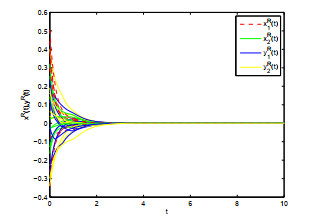









 DownLoad:
DownLoad:
